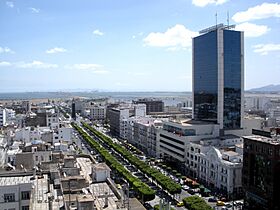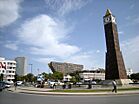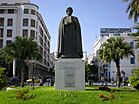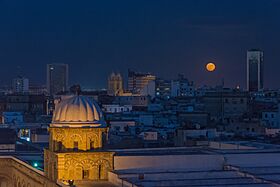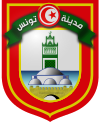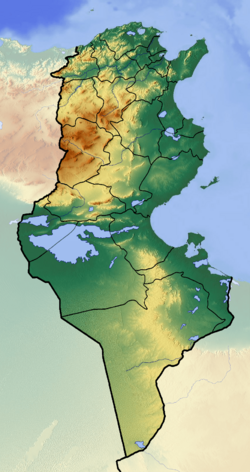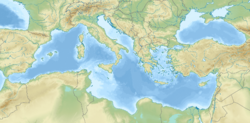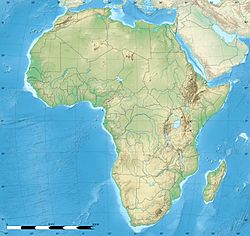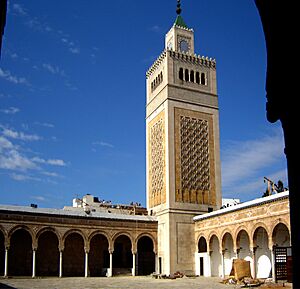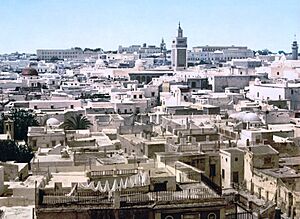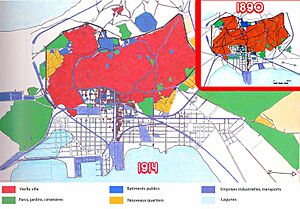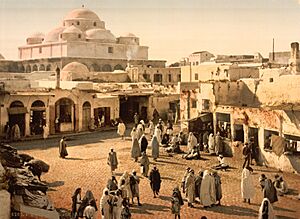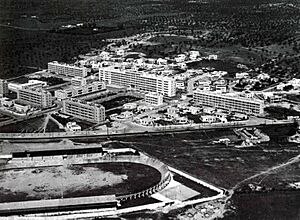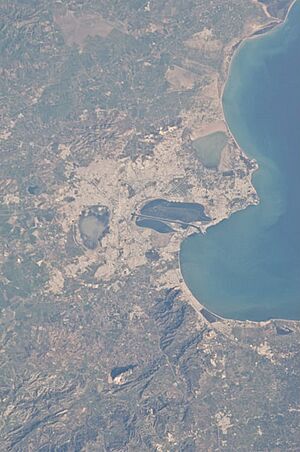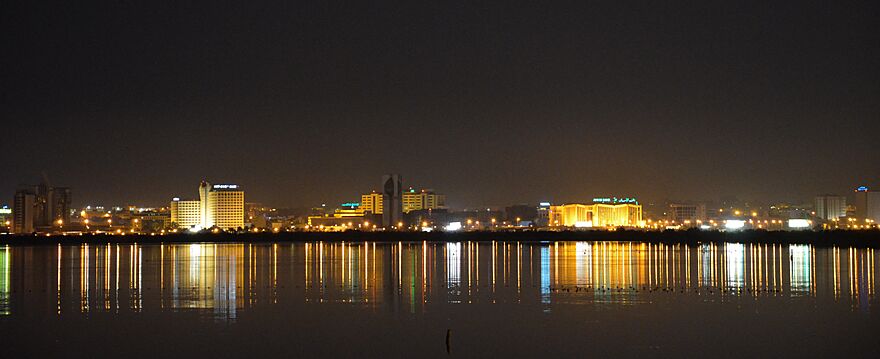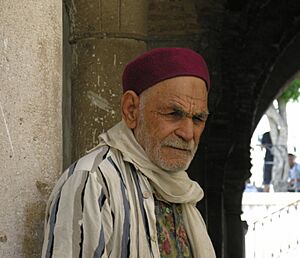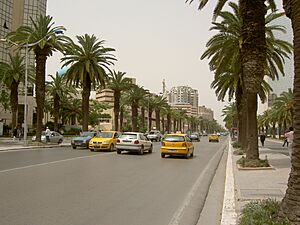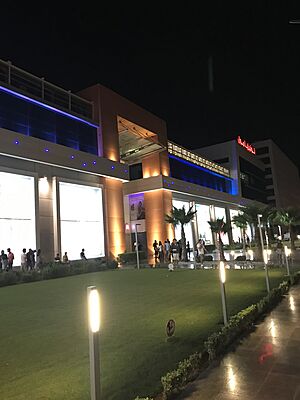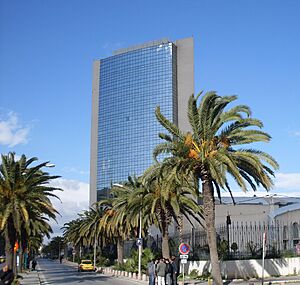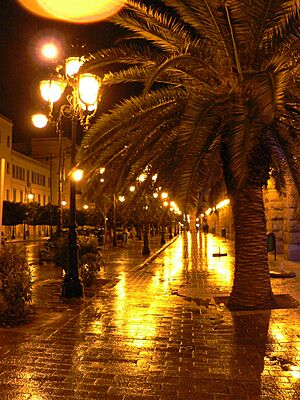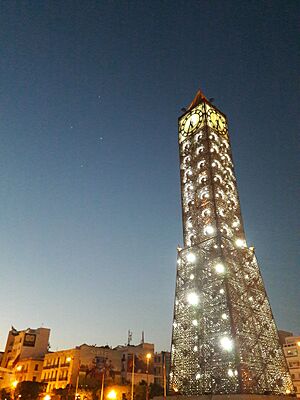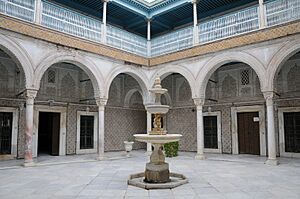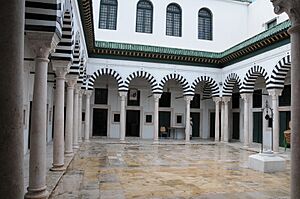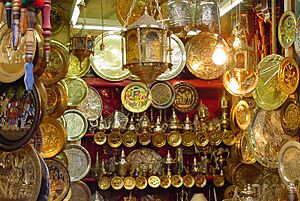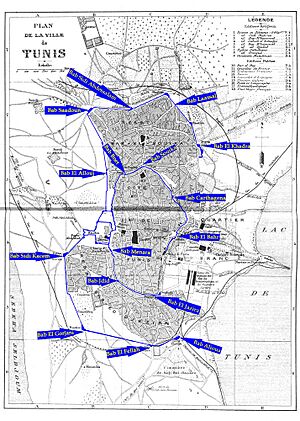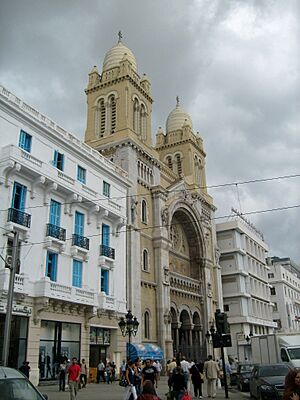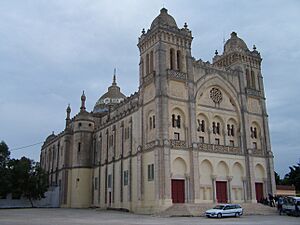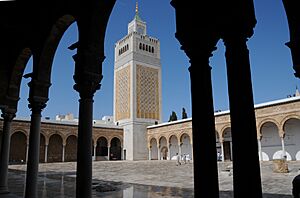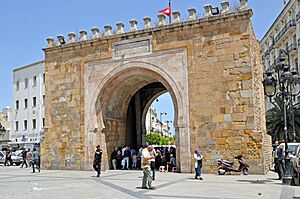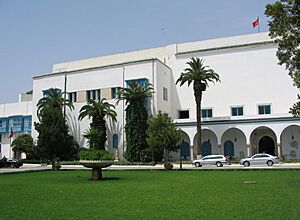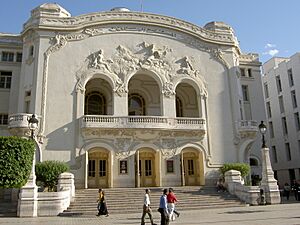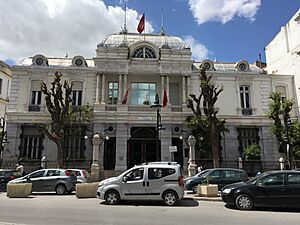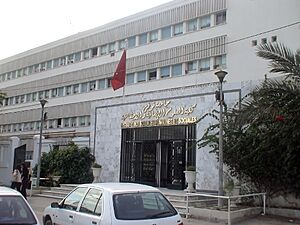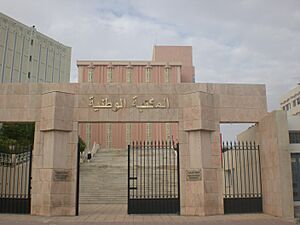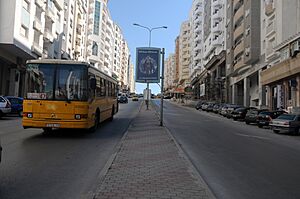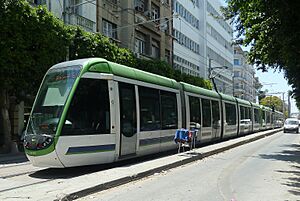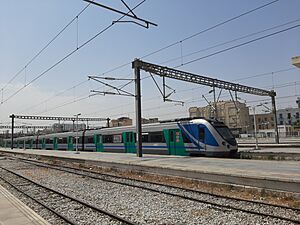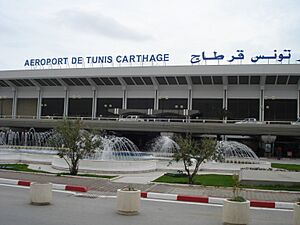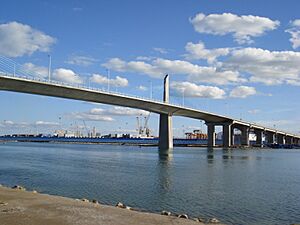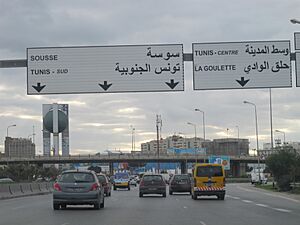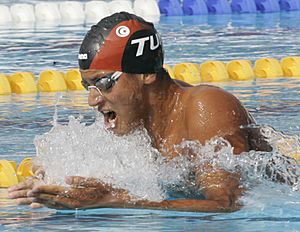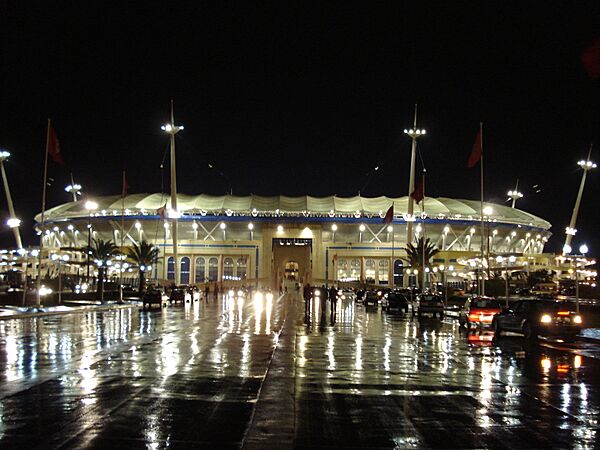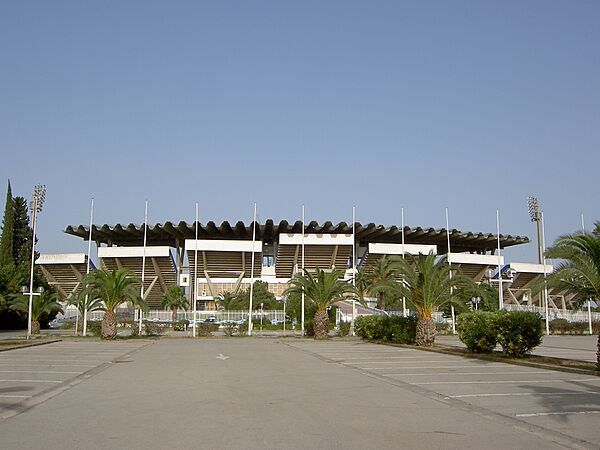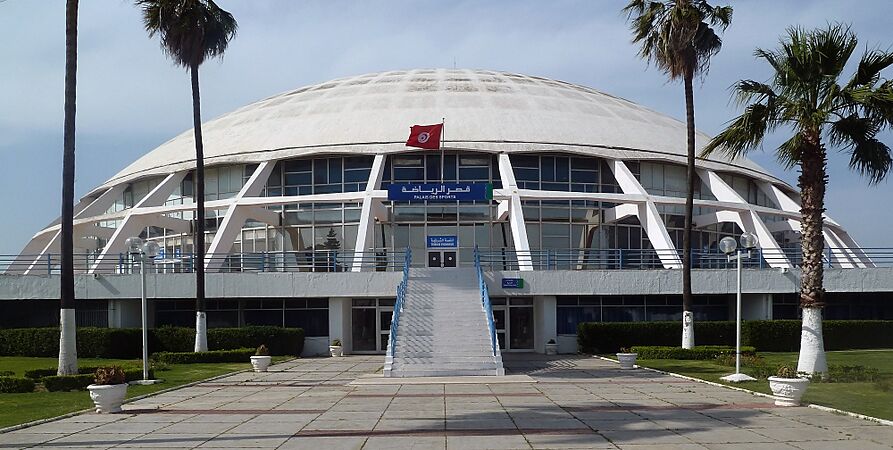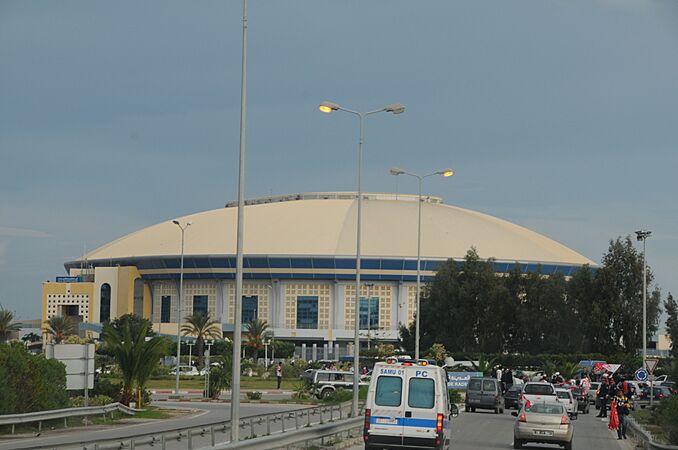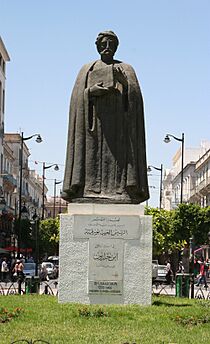Tunis facts for kids
Quick facts for kids
Tunis
تونس
|
|||
|---|---|---|---|
|
From top, left to right: Avenue Habib Bourguiba, Avenue 14 – Janvier 2011, the statue of Ibn Khaldoun, view of Tunis from Sidi Belhassen mountain, view of Sidi Bou Said, view of Tunis at night.
|
|||
|
|||
| Country | |||
| Governorate | Tunis Governorate | ||
| Delegation(s) | El Bab Bhar, Bab Souika, Cité El Khadra, Djebel Jelloud, El Kabaria, El Menzah, El Omrane, El Omrane Superieur, El Ouardia, Ettahrir, Ezzouhour, Hraïria, Medina, Séjoumi, Sidi El Bechir | ||
| Established | 698 AD | ||
| Area | |||
| • Capital city | 104 km2 (40 sq mi) | ||
| • Metro | 2,668 km2 (1,030 sq mi) | ||
| Highest elevation | 41 m (135 ft) | ||
| Lowest elevation | 4 m (13 ft) | ||
| Population
(2023-01-01)
|
|||
| • Capital city | 599,368 | ||
| • Density | 5,794/km2 (15,010/sq mi) | ||
| • Metro | 2,671,882 | ||
| Demonym(s) | Arabic: تونسي Tounsi French: Tunisois |
||
| Time zone | UTC+01:00 (Central European Time) | ||
| • Summer (DST) | (Not Observed) | ||
| Postal code |
1xxx, 2xxx
|
||
| ISO 3166 code | TN-11, TN-12, TN-13 and TN-14 | ||
| geoTLD | .tn | ||
Tunis (Arabic: تونس) is the capital and largest city in Tunisia. The bigger area of Tunis, called "Grand Tunis", has about 2,700,000 people. As of 2020[update], it is the third-largest city in the Maghreb region. It is also the eleventh-largest city in the Arab world.
Tunis is located on the Gulf of Tunis. It sits behind the Lake of Tunis and the port of La Goulette. The city spreads out along the coast and the hills around it. At its heart is the Medina, which is a World Heritage Site. East of the Medina, you'll find the modern part of the city. This area is called "Ville Nouvelle" and has the grand Avenue Habib Bourguiba. This avenue is often called "the Tunisian Champs-Élysées". It has older buildings next to newer ones. Further east, near the sea, are the towns of Carthage, La Marsa, and Sidi Bou Said.
As the capital, Tunis is the center of Tunisia's government and administration. It is also very important for business and culture.
Contents
What's in a Name?
The name Tunis comes from the Arabic name تونس. This name can be said in a few ways, like "Tūnus" or "Tūnis". An Arab geographer from the 1100s, Yaqut al-Hamawi, wrote about these different ways to say it.
There are different ideas about where the name Tunis came from. Some people think it's linked to an old goddess named Tanith. Many ancient cities were named after their special gods. Others believe it came from Tynes, a place mentioned by ancient writers. This place was similar to an old Berber village in Tunis.
Another idea is that the name comes from a Berber word, ens. This word means "to lie down" or "to spend the night". So, Tunis might mean "night camp" or "a stop". It could have been the last stop before reaching Carthage for travelers. Old Roman writings also mention nearby towns like Tuniza and Thunisa. These towns were on Roman roads and likely served as rest stops.
Tunis Through Time
Ancient Settlements and Carthage
| UNESCO World Heritage Site | |
|---|---|
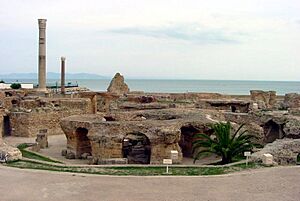 |
|
| Criteria | Cultural: ii, iii, vi |
| Inscription | 1979 (3rd Session) |
| Area | 616.02 ha |
Studying the history of Carthage is hard. The Romans destroyed most of its culture and records after the Third Punic War. So, we have very few original writings from Carthage. We mostly learn about Carthage from Greek and Roman historians. These writers were often rivals or enemies of Carthage. Their stories about Carthage are usually not very friendly.
The area of Tunis was first a Berber settlement. We know about settlements here from the 4th century BC. Tunis was on a hill, which was a great spot to watch ships and traders going to and from Carthage. It was one of the first towns that Carthage controlled. Over the years, Tunis was mentioned in stories about Carthage's wars. For example, during a war in 310 BC, the town changed hands many times.
During a war called the Mercenary War, Tunis might have been a center for local people. Its population was likely made up of farmers, fishermen, and craftspeople. Compared to the old ruins of Carthage, Tunis's ancient ruins are not as big. A writer named Strabo said the Romans destroyed Tunis in 146 BC during the Third Punic War. Both Tunis and Carthage were destroyed. However, Tunis was rebuilt first under the rule of Augustus. It became an important Roman town known for its farming. It was a "way station" or resting place on Roman roads. Tunis became more Roman and later Christian. It was the home of a bishop. But it stayed smaller than Carthage during this time.
Early Islamic Period and Growth
In the late 600s, Arab Muslims took over the region. In 698, a community and a mosque were built near the old ruins. This became the city of Tunis and the Zaytuna Mosque. The Medina of Tunis, the oldest part of the city, comes from this time. The city had a natural advantage because it was on the coast. This allowed it to connect with major ports in southern Europe.
Tunis was important for military reasons early on. The Umayyads knew how important its location was near the Strait of Sicily. A shipyard was built when the city was founded. From the early 700s, Tunis was the main city in the area. It became the naval base for the Umayyads and later the Abbasids in the western Mediterranean Sea. This made it very important for military power.
Under the Aghlabid rulers, Tunis grew in importance. It became one of the most important cities in the caliphate. It was even the capital for a short time, from 902 to 909.
Local people started to resist the rulers in 945. Rebels took over Tunis and looted the city. When the Zirid dynasty took power, the Sunni people in Tunis became less accepting of Shi'ite rule. They carried out attacks against the Shi'ite community. In 1048, the Zirid ruler Al-Muizz ibn Badis stopped obeying the Fatimids. He brought back Sunni practices across the region. This made the Fatimid Caliph Al-Mustansir Billah very angry. To punish the Zirids, he sent the Banu Hilal Arab tribe to the region. A large part of the country was burned. The Zirid capital, Kairouan, was destroyed in 1057. Only a few coastal towns, like Tunis and Mahdia, were saved.
Because of the violence from tribes around the city, the people of Tunis rejected the Zirids. They promised loyalty to the Hammadid prince El Nacer ibn Alennas in 1059. This prince was based in Béjaïa. The governor he appointed brought order back to the country. He then broke away from the Hammadids and started the Khurasanid dynasty. Tunis became its capital. This small independent kingdom helped trade grow again and brought peace and wealth back to the region.
Tunis Becomes the Capital
In 1159, the Almohad leader 'Abd al-Mu'min took Tunis. He removed the last Khurasanid ruler and set up a new government. This Almohad takeover made Tunis the most important city in Tunisia. Before, it was less important than Kairouan and Mahdia. Now, Tunis became the capital of the province.
In 1228, Governor Abu Zakariya took power. A year later, he became Emir and started the Hafsid dynasty. Tunis became the capital of a Hafsid kingdom that reached towards Tripoli and Fez. Walls were built to protect the growing capital. These walls surrounded the medina, the kasbah, and the new parts of Tunis. In 1270, Louis IX of France briefly took the city. He hoped to convert the Hafsid ruler to Christianity. King Louis easily captured Carthage. But his army soon got sick with dysentery. Louis himself died outside the capital's walls. His army was forced to leave.
At the same time, many Andalusian Muslims and Jews came to Tunis. They were fleeing the reconquest of Spain. These newcomers helped the Hafsid capital become wealthy and grow its intellectual life.
During the Almohad and Hafsid times, Tunis was one of the richest and grandest cities in the Islamic world. It had about 100,000 people. The Hafsids had Christian soldiers who lived in a special neighborhood. They had a church dedicated to Saint Francis of Assisi. Visitors said it was "very beautiful and great". It was even allowed to ring its bell, which was usually forbidden.
A famous traveler, Ibn Battuta, visited Tunis during this time. When he arrived, many people came out to greet his group. They were curious and asked questions. But no one greeted Ibn Battuta personally, which made him very sad. He felt lonely and cried. Then, one of the pilgrims noticed he was upset. He went and talked to Ibn Battuta until they entered the city. The Sultan of Tunis at the time was Abu Yahya. During Ibn Battuta's visit, the Festival of the Breaking of the Fast was happening. Many people gathered to celebrate in fancy clothes. Abu Yahya arrived on horseback with his family. After the celebration, everyone went home.
Spanish and Ottoman Control
The Ottoman Empire took control of Tunis in 1534. Hayreddin Barbarossa captured it from the Hafsid Sultan Mulai Hassan. Mulai Hassan then went to the court of Charles V, Holy Roman Emperor and King of Spain. Charles had been losing ships to pirates from Djerba, Tunis, and Algiers. He agreed to help Mulai Hassan get his city back if Mulai Hassan accepted Spanish rule. In 1535, Charles led a naval trip and recaptured Tunis. This victory against the pirates is shown in a tapestry in the Royal Palace of Madrid. The Spanish governor of La Goulette built up the island of Chikly in Lake Tunis. This was to make the city's defenses stronger between 1546 and 1550.

The Ottoman leader Uluç Ali Reis took Tunis back in 1569 with an army. But after the Battle of Lepanto in 1571, the Spanish, led by John of Austria, recaptured the city. They put the Hafsid ruler back in charge in October 1573. After these fights, the city finally fell to the Ottomans in August 1574.
Tunis became an Ottoman province ruled by a Pasha. This Pasha was chosen by the Sultan in Constantinople. The country gained some independence. After 1591, the Ottoman governors (Beys) became quite independent. Both piracy and trade continued to grow. Under the rule of deys and beys, the capital became lively again. Its population grew with people from different backgrounds, including Moorish refugees from Spain. Economic activities became more varied. Besides traditional industry and trade, there was also the activity of the Barbary pirates. This was their golden age. Money from the trade in Christian captives allowed rulers to build beautiful buildings. These buildings brought back the old architectural styles.

In April 1655, the English admiral Robert Blake was sent to the Mediterranean. He was there to get money from states that had attacked English ships. Only the Bey of Tunis refused. So, Blake's fifteen ships attacked the Bey's arsenal. They destroyed nine Algerian ships and two shore batteries. This was the first time in naval history that shore batteries were destroyed without landing soldiers.
In the early 1700s, Tunisia started a new period with the Husainid dynasty. These rulers greatly improved the city and its buildings. Tunis became a thriving center for trade. In 1756, Algerians captured Tunis. They took advantage of disagreements within the ruling family. Hammouda Bey faced attacks from the Venetian fleet. The city also had a rebellion in 1811. Under Hussein Bey II, the British (1826) and French (1827) defeated the navy. This led to the French becoming more involved in the city and its economy.
Different sources say that in the 1800s, Tunis had between 90,000 and 110,000 people. Later in the 1800s, more Europeans, especially French people, moved to Tunis. This greatly increased the city's size. Because of this, the old city walls started to be torn down from 1860. This made space for new areas. The city grew beyond its old boundaries and the lake. New areas were modernized with running water (1860), gas lighting (1872), roads, and trash collection (1873). They also got better connections to nearby suburbs and the city center. Traditional crafts and trades became less common. Newcomers increased trade with Europe and brought in the first modern industries and new ways of city life.
French Protectorate and World War II
The start of the French protectorate in 1881 changed Tunis a lot. The city quickly grew outside its old walls. It became two parts: an old city with Arab people and a new city with immigrants. The new city had a different layout from the traditional medina. Tunis also got new water, gas, and electricity systems from the French. Public transport and other services were also built.
Under French rule, many Europeans moved to Tunis. About half of the city's population was European. The city expanded, creating new wide streets and neighborhoods.
Tunis was peaceful during World War I. After the war, the modern part of the city grew even more. It spread its network of streets in all directions. New towns also appeared around Tunis, becoming part of the city. In terms of money, businesses grew and became more varied. Modern industries kept growing, while traditional ones became less important.
During World War II, Axis forces held Tunis from November 1942 to May 1943. It was their last base in Africa. They were surrounded by Allied forces from Algeria and Libya. On May 7, 1943, Tunis fell to British and U.S. troops. They had defeated the German 5th Panzer Army guarding the city. On May 20, 1943, the Allies held a victory parade. This showed that the fighting in North Africa was over.
After driving the Axis powers out, the Allies used Tunis as a base. From here, they launched attacks on the island of Pantelleria, then Sicily, and finally Italy.
Growth Since Independence
After Tunisia became independent in 1956, Tunis became even more important as the capital. The constitution said that the main government offices must be in Tunis. The city changed quickly. As Tunis grew, more native Tunisians moved in. The differences between the Arab and European parts of the city became less noticeable.
Because more people were moving to the capital, the city kept growing. New areas were built in the suburbs. Old buildings were fixed up and improved. New buildings changed how the city looked. At the same time, the city's economy grew with new industries.
The Arab League, which represents 22 Arab nations, moved its main office to Tunis in 1979. This was because Egypt made peace with Israel. The Arab League moved back to Egypt in 1990.
The Palestine Liberation Organization (PLO) also had its headquarters in Tunis from 1982 to 2003. In 1985, the PLO's office was bombed by Israeli planes. About 60 people were killed.
Tunis in the 21st Century
Many protests happened during the Arab Spring of 2011–12.
On March 18, 2015, two gunmen attacked the Bardo National Museum. They took people hostage. Twenty civilians and one policeman were killed. About 50 others were hurt. Among the dead were visitors from Japan, Colombia, Italy, Poland, and Spain. Tunisian police killed both gunmen. This event was seen as a terrorist attack.
City Geography
Tunis is in northeastern Tunisia. It sits on the Lake of Tunis. A canal connects it to the Gulf of Tunis in the Mediterranean Sea. This canal ends at the port of La Goulette/Halq al Wadi. The ancient city of Carthage is just north of Tunis along the coast. Tunis is at a similar latitude to the southernmost parts of Europe.
The city of Tunis is built on a hill that slopes down to Lake Tunis. These hills include places like Notre-Dame de Tunis and La Kasbah. Their heights are just over 50 metres (160 feet). The city is located on a narrow strip of land between Lake Tunis and Séjoumi. This land strip is called the "Tunis dome" by geologists. It has limestone hills and sediments. It forms a natural bridge. For a long time, major roads connecting to Egypt and other parts of Tunisia branched out from here. These roads also connected to Carthage. This shows how important Tunis was in North Africa and the Mediterranean Sea in ancient times.
The Greater Tunis area covers about 300,000 hectares (1,200 sq mi; 3,000 km2). Only 10% of this area is city. The rest is water (20,000 hectares (77 sq mi; 200 km2) of lakes) and farmland or natural land (250,000 hectares (970 sq mi; 2,500 km2)). However, the city is growing by about 500 hectares each year. This growth is slowly changing the landscape as the city spreads out.
Tunis Suburbs
| Municipality | Population (2004) |
|---|---|
| Ettadhamen-Mnihla | 118,487 |
| Ariana | 97,687 |
| La Soukra | 89,151 |
| El Mourouj | 81,986 |
| La Marsa | 77,890 |
| Douar Hicher | 75,844 |
| Ben Arous | 74,932 |
| Mohamedia-Fouchana | 74,620 |
| Le Bardo | 70,244 |
| Le Kram | 58,152 |
| Oued Ellil | 47,614 |
| Radès | 44,857 |
| Raoued | 53,911 |
| Hammam Lif | 38,401 |
| La Goulette | 28,407 |
| Carthage | 28,407 |
| La Manouba | 26,666 |
| Mornag | 26,406 |
| Djedeida | 24,746 |
| Den Den | 24,732 |
| Tebourba | 24,175 |
| Mégrine | 24,031 |
| Kalâat el-Andalous | 15,313 |
| Mornaguia | 13,382 |
| Sidi Thabet | 8,909 |
| Sidi Bou Saïd | 4,793 |
| El Battan | 5,761 |
| Borj El Amri | 5,556 |
| Total | 1,265,060 |
| Sources: National Institute of Statistics | |
After World War II, towns quickly grew around Tunis. These suburbs now make up a large part of the Tunis metropolitan area. Their population grew from 27% of the total in 1956 to 50% in 2006.
Tunis Climate
Tunis has a hot-summer Mediterranean climate. This means it has hot, dry, and long summers. Winters are mild with some rain. The city's location, the nearby Mediterranean Sea, and the hills also affect the weather.
Winter is the wettest time of year. More than a third of the yearly rain falls then. It rains on average every two or three days. The sun can still warm the temperature from 7 °C (45 °F) in the morning to 16 °C (61 °F) in the afternoon. Freezing temperatures are rare. The lowest temperature ever recorded was −2.0 °C (28.4 °F) on January 18, 1979.
In spring, rainfall drops by half. The sun shines a lot in May, for about 10 hours a day. In March, temperatures can be between 8 and 18 °C (46 and 64 °F). In May, they are between 13 and 24 °C (55 and 75 °F). However, temperatures can get very high even in April, reaching 40 °C (104 °F).
In summer, there is almost no rain. The sun shines the most. Average temperatures in June, July, August, and September are very high. Sea breezes can make the heat less intense. But sometimes, sirocco winds make it hotter. Occasional thunderstorms can happen quickly in the afternoon, especially after very hot weather. They usually don't bring rain but might have a brief shower. The highest temperature ever recorded was 49.0 °C (120.2 °F) on July 24, 2023.
In autumn, it starts to rain again. Often, there are short thunderstorms. These can sometimes cause floods in parts of the city. November marks a change from the heat. Average temperatures are between 11 to 20 °C (52 to 68 °F).
| Climate data for Tunis (Tunis–Carthage International Airport) 1991–2020, extremes 1943—present | |||||||||||||
|---|---|---|---|---|---|---|---|---|---|---|---|---|---|
| Month | Jan | Feb | Mar | Apr | May | Jun | Jul | Aug | Sep | Oct | Nov | Dec | Year |
| Record high °C (°F) | 25.6 (78.1) |
28.7 (83.7) |
36.5 (97.7) |
33.1 (91.6) |
41.4 (106.5) |
47.0 (116.6) |
49.0 (120.2) |
49.0 (120.2) |
44.4 (111.9) |
40.0 (104.0) |
34.5 (94.1) |
29.6 (85.3) |
49.0 (120.2) |
| Mean daily maximum °C (°F) | 15.7 (60.3) |
17.3 (63.1) |
20.1 (68.2) |
22.4 (72.3) |
25.1 (77.2) |
29.5 (85.1) |
33.0 (91.4) |
32.7 (90.9) |
25.2 (77.4) |
22.3 (72.1) |
19.8 (67.6) |
16.5 (61.7) |
25.2 (77.4) |
| Daily mean °C (°F) | 10.7 (51.3) |
12.1 (53.8) |
14.5 (58.1) |
16.6 (61.9) |
20.6 (69.1) |
24.2 (75.6) |
27.1 (80.8) |
26.3 (79.3) |
21.8 (71.2) |
20.5 (68.9) |
14.8 (58.6) |
11.8 (53.2) |
19.2 (66.6) |
| Mean daily minimum °C (°F) | 5.6 (42.1) |
6.8 (44.2) |
8.9 (48.0) |
10.8 (51.4) |
14.0 (57.2) |
17.9 (64.2) |
21.2 (70.2) |
21.7 (71.1) |
18.4 (65.1) |
14.6 (58.3) |
9.8 (49.6) |
7.0 (44.6) |
13.1 (55.6) |
| Record low °C (°F) | −5.3 (22.5) |
−2.6 (27.3) |
0.0 (32.0) |
1.7 (35.1) |
5.2 (41.4) |
10.6 (51.1) |
13.0 (55.4) |
11.7 (53.1) |
10.9 (51.6) |
5.6 (42.1) |
−1.1 (30.0) |
−0.1 (31.8) |
−5.3 (22.5) |
| Average precipitation mm (inches) | 73.0 (2.87) |
71.1 (2.80) |
72.6 (2.86) |
58.1 (2.29) |
27.2 (1.07) |
6.0 (0.24) |
2.1 (0.08) |
5.0 (0.20) |
19.9 (0.78) |
55.7 (2.19) |
79.2 (3.12) |
85.3 (3.36) |
555.2 (21.86) |
| Average precipitation days (≥ 1.0 mm) | 6.8 | 6.5 | 6.4 | 6.2 | 4.2 | 1.3 | 0.6 | 1.0 | 2.6 | 5.8 | 6.9 | 7.2 | 55.5 |
| Average relative humidity (%) | 76 | 74 | 73 | 71 | 68 | 64 | 62 | 64 | 68 | 72 | 74 | 77 | 70 |
| Mean monthly sunshine hours | 164.1 | 176.8 | 220.0 | 235.8 | 291.4 | 317.3 | 354.6 | 327.3 | 250.7 | 220.7 | 175.2 | 157.8 | 2,891.7 |
| Mean daily sunshine hours | 4.7 | 5.7 | 6.4 | 7.5 | 9.1 | 10.3 | 11.5 | 10.6 | 8.6 | 7.0 | 5.8 | 4.8 | 7.7 |
| Source 1: Institut National de la Météorologie (precipitation days/humidity 1961-1990, sun 1981–2010) | |||||||||||||
| Source 2: NOAA (humidity/daily sun 1961–1990), Meteo Climat (record highs and lows) | |||||||||||||
Tunis Population

| Year | Municipality | Metropolitan area |
|---|---|---|
| 1891 | 114,121 | |
| 1901 | 146,276 | |
| 1911 | 162,479 | |
| 1921 | 171,676 | 192,994 |
| 1926 | 185,996 | 210,240 |
| 1931 | 202,405 | 235,230 |
| 1936 | 219,578 | 258,113 |
| 1946 | 364,593 | 449,820 |
| 1956 | 410,000 | 561,117 |
| 1966 | 468,997 | 679,603 |
| 1975 | 550,404 | 873,515 |
| Sources: Sebag (1998) | ||
After Tunisia became independent, the population of the Tunis area kept growing. It grew by 21.1% from 1956 to 1966. It grew by 28.5% from 1966 to 1975. This steady growth changed the city's population. Many Europeans left after decolonization. Tunisians from other parts of the country moved to Tunis to fill these gaps.
The city of Tunis now has over 2,000,000 people. After independence, the Tunisian government started family planning. This was to help manage the city's and country's population growth. Between 1994 and 2004, the population of Tunis grew by more than 1.03% each year. In 2004, it made up 9.9% of Tunisia's total population.
Like the rest of Tunisia, the number of people who can read and write in Tunis grew fast. This happened in the second half of the 20th century. The education level in Tunis is slightly higher than the national average. Only the nearby area of Ariana, which has many schools, has a higher education level.
Tunis Economy
Economic Overview
Tunis makes products like textiles, carpets, and olive oil. Tourism also brings a lot of money to the city.
Tunis is the center of Tunisia's government and culture. It is also the heart of the Tunisian economy. It is the main industrial and economic hub of the country. A third of all Tunisian companies are in Tunis. This includes almost all companies with more than fifty employees. Tunis produces a third of the country's total economic output.
Tunis attracts foreign investors. About 33% of foreign companies, 26% of investments, and 27% of jobs are in Tunis. According to a 2017 study, Tunis has the lowest cost of living for people from other countries. The number of university graduates who are unemployed is growing. Also, many older people still cannot read or write. The number of people living in poverty is falling nationwide. But it remains higher in city areas. Unemployment is high among young people aged 18 to 24. One in three young people in Greater Tunis is unemployed.
A company called Gulf Finance House has invested $10 billion. This money is for building the Tunis financial harbor. This project aims to make Tunisia a gateway between Africa and Europe. It hopes to boost Tunisia's economy and bring more tourists. The project is currently being planned.
Economic Sectors
Most of Tunis's economy is in the tertiary industry (services). The city is the biggest financial center in Tunisia. It has the main offices of 65% of financial companies. Industrial jobs are slowly becoming less important. However, manufacturing is still very strong. Tunis has 85% of the industrial businesses in its four areas. There is a trend for special industrial zones to spread into the suburbs.
Farming is also important in special farming areas in the suburbs. This is especially true for wine and olive oil. The land is generally flat. The two main rivers, the Medjerda and the Milian, make the soil fertile. Tunis has several large plains. The most productive are in Ariana and La Soukra (north). Also, the plains of Manouba (west) and Mornag (south) are very fertile. Water is easy to get from deep wells. This water helps grow different crops. The soils are heavy and have limestone in the north. But they are lighter and sandy with clay in the south.
Farming in Tunis is very diverse. Durum wheat is grown in Manouba. Olives and olive oil come from Ariana and Mornag. Wine is produced in Mornag. Fruits, vegetables, and legumes are grown in all regions.
City Layout and Landmarks
Urban Landscape
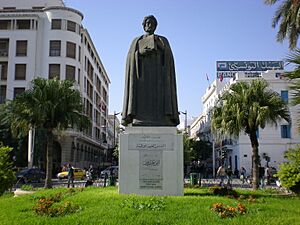
The Medina is the old part of the city. It is built on a gentle slope leading down to the Lake of Tunis. The Medina is home to many old buildings. These include palaces like the Dar Ben Abdallah and Dar Hussein. There is also the tomb of Tourbet el Bey and many mosques like the Al-Zaytuna Mosque. Some of the old walls around it are now gone. It is next to two suburbs: Bab Souika in the north and Bab El Jazira in the south. The Halfaouine area, near Bab Souika, became famous from the film 'Halfaouine Child of the Terraces'.
East of the old city, the modern city grew. This started with the French Consulate. The French protectorate built it in the late 1800s. It was built on open land between the old city and the lake. The main street in this part of the city is Avenue Habib Bourguiba. The French designed it to be like the Champs-Élysées in Paris. It has cafes, big hotels, shops, and cultural places. On both sides of this tree-lined avenue, the city expanded. The northern side has homes and businesses. The southern side has factories and poorer areas.
Southeast of Avenue Bourguiba is the La Petite Sicile (Little Sicily) area. It is next to the old port. It got its name from the Italian workers who first lived there. This area is now being rebuilt with new projects, including twin towers. North of Avenue Bourguiba is the La Fayette area. It still has the Great Synagogue of Tunis and the Habib Thameur Gardens. These gardens are on the site of an old Jewish cemetery. Also to the north is the long Avenue Mohamed V. This avenue leads to the Boulevard of 7 November. It goes through the area with big banks, hotels, and Abu Nawas Lake. Finally, it reaches the Belvedere area around Pasteur Square. This is where Belvedere Park is, the largest park in the city. It has a zoo and the Pasteur Institute. Further north are the fancy neighborhoods of Mutuelleville. These have the French Lycée Pierre-Mendès-France, the Sheraton Hotel, and some embassies.
Even further north of Belvedere Park, beyond the Boulevard of 7 November, are the neighborhoods of El Menzah and El Manar. These areas now reach the tops of the hills overlooking the north of the town. They have many homes and businesses. West of the park is the El Omrane area. This area has the main Muslim cemetery in the capital and public transport warehouses. Heading east is the Tunis-Carthage International Airport. There are also the Borgel neighborhoods, named after the Jewish and Christian cemeteries. And the Montplaisir neighborhood. Beyond that, several kilometers northeast, on the road to La Marsa, is the Berges du Lac. This area was built on land taken from the north shore of the lake near the airport. It has offices for Tunisian and foreign companies, many embassies, and shops.
Southwest of the Medina, on the hills across the Isthmus of Tunis, is the Montfleury area. Then, down to the foothills of Séjoumi, is the poorer neighborhood of Mellassine. Northwest of Mellassine, north of the National Route 3, is the city of Ezzouhour. This city covers more than three metres (9.8 feet) and is divided into five parts. It is still surrounded by farms that grow vegetables for many of the local markets.
The south of Tunis has less wealthy neighborhoods. This is mainly because of the many factories in this part of the city. These include Jebel Jelloud, in the southeast of Tunis. It has heavy industry like cement production and phosphate processing plants. The main cemetery in Tunis, the Djellaz Cemetery, is in this part of town. It sits on the slopes of a rocky hill.
The Historic Medina
| UNESCO World Heritage Site | |
|---|---|
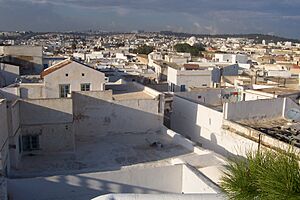
Roofs of the medina
|
|
| Criteria | Cultural: ii, iii, v |
| Inscription | 1979 (3rd Session) |
| Area | 296.41 ha |
| Buffer zone | 190.19 ha |
The medina of Tunis has been a UNESCO World Heritage Site since 1979. The Medina has about 700 old buildings. These include palaces, mosques, mausoleums, schools (madrasas), and fountains. They date from the Almohad and Hafsid periods. Some of these old buildings are:
- The Aghlabid Al-Zaytouna Mosque ("Mosque of the Olive"). It was built in 723 to celebrate the new capital.
- The Dar El Bey, or Bey's Palace. It shows architecture and decorations from many different styles and times. It is believed to be built on the remains of a Roman theater. It also sits on the site of a 10th-century palace.
The Medina covers 270 hectares (about 667 acres). It has over 100,000 people. This is one-tenth of Tunis's population. The Medina of Tunis does not have straight lines or perfect geometric shapes. However, studies in the 1930s showed that its layout is not random. The houses are built based on social and cultural rules.
You can find many types of buildings in the Medina. These include homes (palaces and townhouses), government buildings (libraries and offices), religious places (mosques and zaouïas), and service buildings (shops and fondouks). The idea of public space is a bit unclear in the Medina. Streets are seen as an extension of homes. Shops often spill out onto public roads. Today, each area has its own culture. There can be strong rivalries between them.
The northern part supports the football club Esperance Sportive de Tunis. The southern part supports the rival Club Africain. The Medina also has social divisions. The areas of Tourbet el Bey and the Kasbah are for wealthy people. They have judges and politicians. The streets of Pacha are often for military people and the middle class.
The Al-Zaytuna Mosque was founded in 698. The area around it grew throughout the Middle Ages. This divided Tunis into a main town and two suburbs. One was in the north (Bab Souika) and one in the south (Bab El Jazira). This area became the capital of a powerful kingdom during the Hafsid era. It was seen as a religious, intellectual, and economic center. It connected the Middle East, Africa, and Europe. You can see a mix of styles here. Andalusian styles blend with eastern influences. There are also Roman or Byzantine columns and typical Arab architecture with archways.
Old architecture is also found in private homes and small official palaces. The sovereign's palace in Kasbah is another example. Some palaces and houses are from the Middle Ages. But many grand houses were built in the 17th, 18th, and 19th centuries. Examples include Dar Othman (early 1600s) and Dar Ben Abdallah (1700s). Also, Dar Hussein and Dar Cherif. If you add the mosques (about 200), the schools (El Bachia, Slimania, etc.), the zaouïas (Sidi Mahrez, Sidi Ali Azouz), and tombs, there are almost 600 historical buildings in Tunis.
Unlike other cities, Tunis's old heart has not suffered much from natural disasters. It also hasn't had major changes to its city plan. The main conflicts happened more recently, after the country gained independence. This is why UNESCO made it a World Heritage Site in 1979. In the early 2000s, the Medina was one of the best-preserved old cities in the Arab world.
Along the main streets, you can see buildings from 1850–1950. These include government buildings for nine ministries and the Tunis city hall.
Other Important Places
- The Bardo Museum was once a 13th-century Hafsid palace. It is in the suburbs of Tunis. It has a large collection of Roman mosaics. It also has other old items from Ancient Greece, Tunisia, and the Arab period.
- The ruins of Carthage are nearby. They are along the coast to the northeast. You can see many ancient ruins there.
Souks (Markets)
The souks are a group of covered streets. They are filled with shops and traders. Each area specializes in certain goods. You can find clothing, perfumes, fruits, books, and wool. Fish sellers, blacksmiths, and potters are usually on the edges of the markets.
North of the Al-Zaytuna Mosque is the Souk El Attarine. It was built in the early 1700s. It is famous for its essences and perfumes. From this souk, a street leads to the Souk Ech-Chaouachine. This market sells chachia (caps). The main company there is one of the oldest in the country. Its owners are often descendants of people who came from Spain.
Next to El Attarine are two other souks. The first, along the west side of the Al-Zaytuna Mosque, is the Souk El Kmach. It is known for its fabrics. The second is the Souk El Berka. It was built in the 1600s and has embroiderers and jewelers. Because it sells valuable items, it is the only souk that is closed and guarded at night. In the middle, there is a square where the old slave market was until the mid-1800s.
Souk El Berka leads to Souk El Leffa. This souk sells many carpets, blankets, and other woven goods. It continues with the Souk Es Sarragine, built in the early 1700s. This market specializes in leather. On the edges are the souks Et Trouk, El Blat, El Blaghgia, El Kébabgia, En Nhas (copper), Es Sabbaghine (dyeing), and El Grana. El Grana sells clothing and blankets and was run by Jewish merchants.
City Walls and Gates
From its early days, Tunis was an important military base. An Arab geographer wrote that in the 800s, Tunis had brick and clay walls. The side facing the sea had stone walls. Bab El-Jazeera, possibly the oldest southern gate, led to the southern road. Bab Cartagena led to Carthage, which was important for getting building materials. Bab Souika had a key role in controlling roads to Bizerte, Béja, and Le Kef. Bab Menara opened into the medina and the El Haoua suburb. Bab El Bhar allowed access to places where Christian merchants lived.
As the capital grew under the Hafsids, two new suburbs appeared outside the walls. These were Bab El Jazira in the south and Bab Souika in the north. In the early 1300s, Hafsid ruler Darba Abû al-Muhammad al-Mustansir Lihyânî ordered new walls. These walls included the Medina and the two new suburbs. Six new gates were built. These included Bab El Khadra, Bab Saadoun, and Bab El Fellah. During the Ottoman period, four more gates were added. These were Bab Laassal and Bab El Gorjani. Tunis still has some of these gates, like Bab El Khadra, Bab El Bhar, and Bab Jedid. But some of the older ones are now gone.
Places of Worship
In Tunis, most places of worship are Muslim mosques. There are also Christian churches and temples. These include Roman Catholic Archdiocese of Tunis churches, Protestant churches, and Evangelical Churches.
Like the rest of Tunisia, most people in Tunis (about 99%) are Sunni Muslim. The capital has many mosques with different architectural styles. These styles show when they were built. The main and oldest mosque is the Al-Zaytuna Mosque. It was founded in 689 and built in 732. It is in the heart of the Medina. It follows the Maliki rite, like most mosques in Tunisia. It was rebuilt in 864. It was a very important place of worship, culture, and learning. The University of Ez-Zitouna was located there until Tunisia became independent. It still hosts major ceremonies for Muslim holidays. The president often attends these events.
The Medina has most of the capital's major mosques. These were built before the French protectorate. The mosque in the Kasbah was founded in 1230. It has followed the Hanafi rite since 1584. You can recognize it by its dome and minaret. The minaret is similar to the Koutoubia in Marrakesh and is the tallest in the city. Ksar Mosque, also Hanafi, is in front of Dar Hussein. It was built in the 1100s. The Hammouda Pasha Mosque, built in 1655, was the second Hanafi mosque in Tunis. Youssef Dey Mosque was first a public speaking place. It became a mosque in 1631. The Sidi Mahrez Mosque is the largest Hanafi mosque in size. Built in 1692, it looks like the Ottoman Süleymaniye Mosque in Istanbul. The Saheb Ettabaâ Mosque, built between 1808 and 1814, was the last mosque built by the Husseinites before the French took over.
Modern churches in Tunis show the French presence for half a century. Tunis is home to the Diocese of Tunis. Its main church is the Cathedral of St Vincent de Paul. This church was built in 1897 on the site of an old Christian cemetery. There are other Catholic churches, like St. Joan of Arc. There are also the Protestant Reformed Church and the Anglican church Saint-Georges.
Greeks have had a strong presence in the city since ancient times. Tunis is the main office for the Greek Orthodox Holy Archdiocese of Carthage. This covers Algeria, Mauritania, Morocco, and Tunisia. It belongs to the Patriarchate of Alexandria and All Africa. Its cathedral, a small school, and other buildings are in Central Tunis. In total, Tunisia has three Greek Orthodox and two Russian Orthodox churches. The Coptic Orthodox Church of Alexandria also has authority in Tunisia. The small Orthodox community is centered around the Greek Orthodox Church (1862) and the Russian Orthodox Church (1957). This shows that a small group of Russian immigrants lives in Tunisia.
Judaism has a long history in the city. This is despite many Jewish people leaving after independence. Places of worship include Beit Yaacouv Synagogue and the Great Synagogue of Tunis. The Great Synagogue was built in the late 1940s. It replaced an older one that was torn down as part of a Jewish area rebuilding project.
Parks and Green Spaces
Tunis has some large parks. Many of them were created in the late 1800s by the French. The biggest park is Belvédère Park. It was founded in 1892 and overlooks Lake Tunis. It is the oldest public park in the country. It is designed in a natural, landscape style common in France. The park covers over one hundred hectares. You can explore it on foot or by car. It is also home to Tunis Zoo, which has African animals. The Museum of Modern Art is also there.
Habib Thameur garden in Tunis has a central pond and flower beds. The Gorjani garden is an English garden. It is in the southwest of the city. It has an irregular shape, partly because of the hilly land.
Tunis Culture
Museums in Tunis
The Bardo National Museum is in an old palace. It was the palace of the Bey of Tunis since the late 1700s. It is the most important archaeological museum in the Maghreb. It has one of the world's richest collections of Roman mosaics. Its collections grew quickly because of many archaeological discoveries nearby.
In 1964, the Dar Ben Abdallah palace became the Museum of Arts and Popular Traditions. This palace likely dates back to the 1700s. In its display rooms, it has many traditional items. These items show the daily lives of families from the Medina quarter.
The Museum of the National Movement is in Dar Maâkal Az-Zaïm. This was the home of nationalist Habib Bourguiba. He lived there during the fight for independence. After independence, a museum was built there. It tells the story of the national struggle between 1938 and 1952.
The National Military Museum opened in 1989. It is in the western suburbs of the city. It has a collection of 23,000 weapons. 13,000 of these weapons are from the 1800s. Some were used by Tunisian troops during the Crimean War.
Music in Tunis
Tunis has some of the most famous music schools in the country. The Rachidia was started in 1934. Its goal was to protect Arab music, especially Tunisian and malouf music. The group has 22 members, including musicians and singers.
The Musical Troupe of the City of Tunis was created in 1954 by Salah El Mahdi. In 1955, his student Mohamed Saâda took charge of the group. It had the best artists at the time. Later, it joined with the Radio Tunis group. This group helped many Tunisian singers become famous, like Oulaya.
The Association of Arab Orchestra of the City of Tunis started in 1982. It was a workshop linked to the city's cultural center. It worked to promote Arab music. It also focused on music education and training. The Tunisian Symphony Orchestra was created in 1969. It performs monthly concerts at the Municipal Theater and other cultural places.
Performing Arts
Tunis is a center for Tunisian culture. The Théâtre municipal de Tunis opened on November 20, 1902. It shows opera, ballet, concerts, and plays. Many Tunisian, Arab, and international performers appear on its stage. The National Theatre of Tunisia is an important public theater in Tunis. Since 1988, it has been in the Khaznadar palace. This palace is from the mid-1800s and is in the Halfaouine area. It was renamed "Theater Palace." In 1993, it also took over the old cinema Le Paris. This cinema has 350 seats. During each "cultural season" (October 1 to June 30), the theater holds over 80 events.
The Al Hamra theater was the second theater to open in Tunis. It is on El Jazira Road. Al Hamra was one of the most famous theaters in the capital during the 1930s and 1940s. After being closed for fifteen years, it became a small theater in 1986. Since 2001, it has been the first Arab-African center for theater training and research. Other theater groups include El Teatro and Étoile du Nord.
Other arts are also present in the capital. The National Center of the Arts started the puppet theater in 1976. The National School of Circus Arts was founded in 1998. This happened after a meeting between the Director of the National Theater and a French arts center director. Many small theaters and cultural centers are spread throughout the city. They show various artistic performances.
Film in Tunis
Film producers and cinemas have been in Tunis for a long time. The first animated film was shown in Tunis by the Lumiere brothers as early as 1896. The first film screenings happened the next year. The first cinema, the Omnia Pathé, opened in October 1908. The first film club opened in Tunis in 1946. The Globe cinema opened in 1965. The Carthage Film Festival is the oldest film festival in Africa. It ran every two years until 2014, and then every year.
In 1990, Ferid Boughedir filmed the famous movie Halfaouine Child of the Terraces in the Halfaouine area. The films The English Patient (1996) and The Last Days of Pompeii (2003) were also filmed in studios in Tunis.
Festivals in Tunis
The city hosts several festivals each year. The largest is the International Festival of Carthage. It takes place in July and August. Founded in 1964, much of the festival is held in Carthage. It uses an old amphitheater that can hold 7,500 people. It features singers, musicians, actors, dancers, and films shown on outdoor screens.
Education in Tunis
Tunis and its suburbs have many of Tunisia's major universities. These include the University of Tunis, Tunisia Private University, and the University of Ez-Zitouna. Also, the University of Tunis – El Manar, the University of Carthage, and the Manouba University. Because of this, Tunis has the most students in Tunisia. as of 2006[update], there were 75,597 students.
There are also other higher education schools. These include the National School of Engineers of Tunis and the Graduate School of Communications of Tunis. Private training schools include the Open University of Tunis.
Among the high schools in the capital, some well-known ones are the Lycée de la Rue du Pacha (founded 1900) and Lycée Bourguiba. Until independence, Sadiki College (founded 1875) and Khaldounia (founded 1896) were also very famous. Because of the French presence, the city still has many French schools. The most important is the Lycée Pierre Mendes-France in Mutuelleville.
Students can study languages at small private schools. For example, the Sidi Bou Said Centre for Languages specializes in Arabic. It offers classes in Modern Standard Arabic, classical Arabic, and different dialects.
Libraries in Tunis
Tunis has some of the most important libraries in Tunisia. This includes the National Library of Tunisia. It first opened in 1924 in the Medina. It was in a building built in 1810 by Hammouda Bey. This building was first a barracks for soldiers, then a jail. The library moved to its current location in 1938. The new building has a reading room, conference room, and laboratories. It also has an exhibition gallery, offices, a restaurant, parking, and green areas.
The library of the Khaldounia is in a former home of a Hafsid scholar. It was founded in 1896. After independence, the library became part of the National Library.
The Dar Ben Achour, built in the 1600s, also has a library. The city of Tunis bought the house in the late 1970s. It was restored in 1983 and turned into a library.
Transport in Tunis
Public Transport
The growing Tunis area has a large public transport system. This includes buses and an above-ground light rail system called the Metro. There is also a regional train line, the TGM. This line connects the city center to its northern suburbs. Multi-lane highways surround the city. They serve the increasing number of private cars in Tunisia.
The Tunis area is served by the métro léger (light metro) and TGM. It also has bus services. It is connected to other places in Tunisia by SNCFT, the national railways. The main transport authorities are the Société des Transports de Tunis (STT) and the Ministry of Transport.
The city has a well-developed public transportation system. It is managed by the Société des transports de Tunis (STT). Besides about 200 bus routes, the first light rail line opened in 1985. The Métro léger de Tunis network has grown since then. It now reaches the suburbs. The capital is also connected to its northern suburbs by a railway line. This line crosses the lake.
New mass transit was planned for Greater Tunis in 2009. This was the RTS (rapid rail network). It was like the Paris RER. It was meant to carry many travelers from distant suburbs to the city center. It would use existing tracks or new ones.
The plan included lines based on population and areas needing coverage. Priority lines included Tunis-Borj Cédria (23 km). Modernization and electrification are already planned for this line. Other lines were Tunis-Mohamedia-Fouchana (19.4 km) and Tunis-Manouba-Mnihla (19.2 km). Also, Tunis-Ezzouhour-Sidi Hassine Séjoumi (13.9 km). The TGM will also be part of the light-rail network. A new line will be built around Ayn Zaghouan and Bhar Lazrag (8.4 km). This would require upgrading the TGM stations for light rail trains. Other projects include a line to the city of Ennasr (8.4 km). Also, extending the Tunis-Ettadhamen to Mnihla (1.7 km). The total length of the network will eventually be about 84 km (52 mi).
Transport Infrastructure
Tunis is served by Tunis-Carthage International Airport. It is located 8 kilometers (5.0 mi) northeast of downtown. It started operating in 1940.
After independence, in the 1960s, the National Board of Seaports modernized the port of Tunis. In the 21st Century, the port of Tunis changed again. It now has a marina as part of the redevelopment of the La Petite Sicile area. Tunis is the starting point for all major roads and highways in Tunisia. The city has a lot of traffic. Car ownership is growing by 7.5% each year. About 40% of cars in Tunisia are in Tunis. Around 700,000 cars are used in the city daily. Because of this, major road projects started in the late 1990s. These included bridges, interchanges, and new roads. They help ease traffic in the capital. The main roads to other Tunisian cities include: Autoroute A1, Tunis-Sfax; Autoroute A3, Tunis-Oued Zarga; and Autoroute A4, Tunis-Bizerte. Also, as part of a big infrastructure project, the city's traffic lights increased from 5,000 to 7,500.
Sports in Tunis
In the early 1900s, many sports groups started in Tunis. This was especially true in schools and colleges. In 1905, the Muslim Association of Tunisia brought students together. They organized gymnastics. A regional gymnastics competition was held in Tunis in 1912. Thousands of French gymnasts took part.
Football came to Tunis on September 15, 1904. The first league, the Racing Club Tunis, was officially created on May 11, 1905. It took some time to get going. But soon, it organized games between school teams. The first game was on June 9, 1907. It was between teams from Lycée Alaoui and Lycée Carnot (1–1).
Football was not the only sport to grow. Between 1928 and 1955, the city hosted nine Grand Prix of Tunis races. Famous drivers like Marcel Lehoux and Tazio Nuvolari competed. The Grand Prix of Tunis has returned since 2000. The city has also hosted the Mediterranean Games twice, in 1967 and 2001. It also holds the Tunis Open tennis tournament. The 2005 World Championship final for men in team handball was played in Tunis.
In 2007, the Tunis area had 24,095 sports licenses for various clubs. For international basketball, the city hosted the FIBA Africa Championship 1965 and the FIBA Africa Championship 1987.
| Club | Stadium | Foundation | Championships of Football |
Championships of volleyball |
Championships of handball |
Championships of basketball |
|---|---|---|---|---|---|---|
| Club Africain | Stade Olympique de Radès Stade El Menzah |
1920 | 12 | 7 | 8 | 2 |
| Espérance Sportive de Tunis | Stade Olympique de Radès Stade El Menzah |
1919 | 20 | 15 | 24 | 3 |
| Stade Tunisien | Stade Chedli Zouiten | 1948 | 4 | 0 | 0 | 0 |
The Esperance Sportive de Tunis (EST), Club Africain (CA), and Stade Tunisien are the main sports clubs in the city. There is a symbolic class difference between the EST's and CA's fans. This is true even though they play at the same stadium. EST is supported by most people. CA, a less wealthy club, is supported by others.
The first real sports facilities were built under the French protectorate. This included the Ksar Said racecourse. Also, the Stade Chedli Zouiten was built in the Belvedere area. This was the main stadium for a long time. Later, it was replaced by the Olympic stadium, Stade El Menzah. EST and CA play their football games there today. The Olympic stadium and village were built for the Mediterranean Games in 1967. A 60,000-seat stadium was also built in Radès for the Mediterranean Games in 2001. It cost about 170 million dinars. Almost half of the money came from South Korean businessmen. The Olympic Village cost about 50 million dinars. In 2008, the government announced a large sports complex. It will have several sports academies, a 20,000-seat stadium, and a swimming center. It is called Tunis Sports City. It will expand around the lake of Tunis, on the road to La Marsa.
Tunis and Other Cities
Twin Cities
Tunis is twinned with these cities:
 Amman, Jordan
Amman, Jordan Rio de Janeiro, Brazil
Rio de Janeiro, Brazil Montreal, Canada
Montreal, Canada Cologne, Germany
Cologne, Germany Doha, Qatar
Doha, Qatar Istanbul, Turkey
Istanbul, Turkey Kuwait City, Kuwait
Kuwait City, Kuwait Muscat, Oman
Muscat, Oman Prague, Czech Republic
Prague, Czech Republic Rabat, Morocco
Rabat, Morocco
Other Partnerships
Famous People from Tunis
- Serge Adda (1948–2004), president of the French TV channel TV5
- Tarak Ben Ammar (born 1949), film producer
- Mustapha Ben Jafar (born 1940), Tunisian politician
- Sophie Bessis, (born 1947), historian, journalist, and researcher
- Roberto Blanco (born 1937), German pop singer and actor
- Alain Boublil (born 1941), French musical author
- Abdelhamid Bouchnak (born 1984), Tunisian filmmaker
- Claudia Cardinale (born 1938), Italian actress
- Karine Chemla (born 1958), historian of mathematics
- Pierre Darmon (born 1934), French tennis player
- Bertrand Delanoë (born 1950), mayor of Paris
- Salah El Mahdi (1925–2014), music expert and composer
- Chokri El Ouaer (born 1966), Tunisian football goalkeeper
- Marc Gicquel (born 1977), French tennis player
- Tahar Haddad (1899–1935), supported women's rights in Tunisia
- Amel Karboul (born 1973), Tunisian business consultant and politician
- Abdellatif Kechiche (born 1960), French film director
- Ibn Khaldun (1332–1406), Arab sociologist and scholar
- Phillip King (1934–2021), British sculptor
- Margaret Maruani (born 1954), Tunisian-French sociologist
- Fouad Mebazaa (born 1933), politician, President of Tunisia in 2011
- Abdelwahab Meddeb (1946–2014), Tunisian-French writer
- Albert Memmi (1920–2020), French writer and sociologist
- Fatma Moalla (born 1939), mathematician
- Khaled Mouelhi (born 1981), Tunisian footballer
- Alberto Pellegrino (1930–1996), Italian fencer
- Nicola Pietrangeli (born 1933), Italian tennis player
- Karim Saidi (born 1983), Tunisian footballer
- Georges Wolinski (1934–2015), French illustrator
- Yazid Zerhouni (born 1937), Algerian politician
See Also
 In Spanish: Túnez (ciudad) para niños
In Spanish: Túnez (ciudad) para niños


